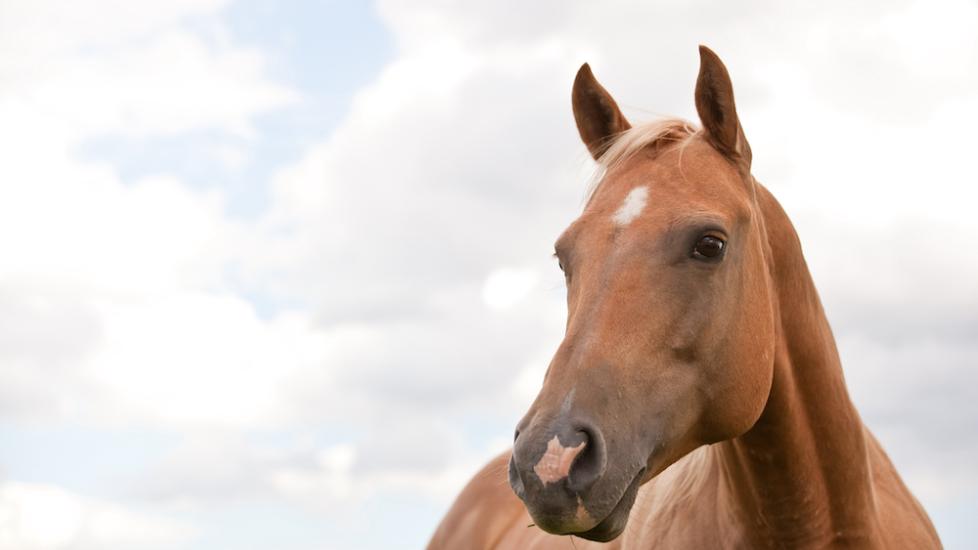HERDA in Horses
What is HERDA in Horses?
Hereditary Equine Regional Dermal Asthenia, also known as HERDA or hyperelastosis cutis, is an uncommon genetic condition that causes skin to become more elastic or stretchy and fragile, more uncomfortable, and more likely to heal slowly.
Quarter horses, particularly of the Poco Bueno line, are the most predisposed individuals for HERDA, and horses typically begin to show clinical signs at around 2–4 years of age when breaking to ride. These painful lesions are commonly found along the back, shoulders, and neck.
Symptoms of HERDA in Horses
Symptoms of HERDA typically include:
-
Elastic and fragile skin, especially along the back and shoulders—the outer layer of skin can even slough off leaving large unsightly wounds
-
Painful skin
-
Development of abrasions and open wounds; these are very painful and interfere with tack and riding
-
Prolonged healing
-
Extensive scarring
-
Possible increased incidence of corneal ulcers
The location of lesions, discomfort, and age of onset makes HERDA a very unique skin condition found in Quarter horses and related breeds.
Causes of HERDA in Horses
HERDA is a genetic condition, caused by a single mutation that affects peptidylprolyl isomerase B (PRIB), which is vital in the formation of collagen. Collagen is a structural protein that provides strength and elasticity to the skin. Because the collagen is not formed correctly with this genetic mutation, the skin is much more fragile.
HERDA is a recessive disorder and affects both mares and geldings equally. Because it is recessive, it means both a mare and stallion must be at least a carrier for there to be a chance for offspring to acquire it.
Carrier horses will not have symptoms of HERDA, but if bred with another HERDA carrier or a HERDA positive horse can produce foals with HERDA.
How Veterinarians Diagnose HERDA in Horses
HERDA is typically tested on horses through a five plus panel test run by University of California Davis, which requires a sample of 20–30 hairs with the root attached. This test checks for HERDA, Glycogen Branching Enzyme Deficiency (GBED), Hyperkalemic Periodic Paralysis (HYPP), Myosin-Heavy Chain Myopathy (MYHM), Malignant Hyperthermia (MH), and Type 1 Polysaccharide Storage Myopathy (PSSM1), all of which are genetic conditions common in Quarter Horses.
When checking a horse’s genotype during this test, a horse’s results will read one of the following:
-
N/N: meaning this horse is normal and not a carrier of the HERDA gene, so cannot pass it on to others.
-
N/HRD: the horse is a carrier, meaning they will not have symptoms, but can potentially pass this disease to offspring.
-
HRD/HRD: horses are HERDA positive and will display symptoms. These horses should not be rebred to prevent passing on this mutated gene.
Registered horses within the AQHA typically require panel testing before breeding.
Recovery and Management of HERDA in Horses
While there is no cure for HERDA, it can be prevented and managed. Many of these horses will become companion horses because they can’t be successfully ridden.
Minimizing sun exposure and trauma/irritation, especially along the back, will help prevent abrasions, skin sloughing, and further pain for these horses. These open wounds often take a long time to heal and can become intensive to manage. Many HERDA positive horses are ultimately euthanized due to complications from infection, ongoing pain, and poor quality of life.
All breeding stock should have genetic testing performed prior to selecting a mare and stallion for use, and responsible choices should be made to eliminate the chances of passing down genetic diseases like HERDA.
HERDA in Horses FAQs
Can a horse live with HERDA?
With proper management and care, a horse can live with HERDA. Some horses are minorly affected than others and may experience less painful or frequent lesions.
What does HERDA do to horses?
HERDA causes improper formation of collagen, causing skin hyper elasticity and weaker skin. This typically leads to frequent wounds, delayed healing, and severe scarring along the back.
What bloodlines carry HERDA?
HERDA is most commonly seen in Quarter horses and related breeds; descendants of Poco Bueno are at highest risk for this mutation.
What does HERDA carrier mean?
A HERDA carrier is a horse that has one HERDA allele in their genotype, meaning they have a potential to pass this genetic abnormality to offspring even though they do not show clinical signs.
Is HERDA dominant or recessive?
HERDA is an recessive mutation, meaning a horse must have both HRD alleles present to suffer from the disease.
What is a HERDA guarantee?
A HERDA guarantee is offered by some stallions that are N/HRD genotype (HERDA carriers). If they sire a foal that is tested HRD/HRD, or HERDA positive before a year of age, the stallion owners typically offer a free rebreeding as long as the foal is not registered.
Featured Image: Getty/emholk
Help us make PetMD better
Was this article helpful?
